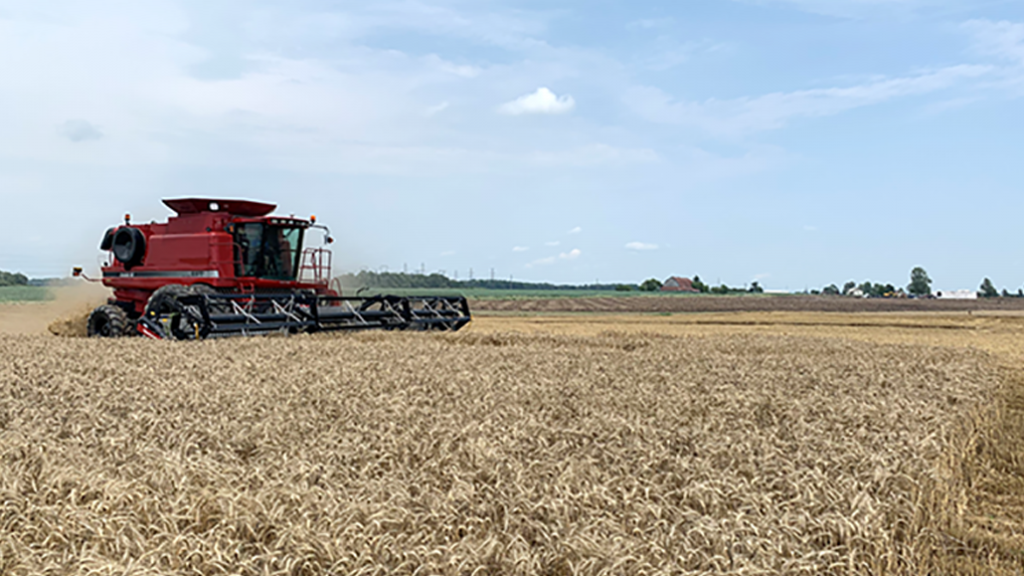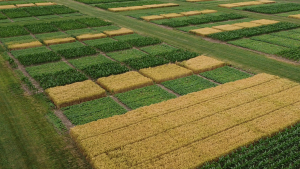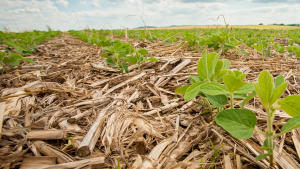Increasing wheat yields
GREAT LAKES YIELD ENHANCEMENT NETORK

THE GREAT LAKES Yield Enhancement Network (YEN) is focused on improving wheat yields for Ontario farmers. The research program recently completed its inaugural season with the 2021 pilot project. The project is a collaborative effort between Grain Farmers of Ontario, Ontario Ministry of Agriculture, Food and Rural Affairs (OMAFRA), Michigan Wheat Program, Michigan State University, the University of Guelph, the Certified Crop Advisor Association, and 40 wheat farmers, from Ontario and neighbouring U.S. states.
| WHAT YOU NEED TO KNOW • The Great Lakes Yield Enhancement Network (YEN) is one of a global series of YENs that help local farmers better understand their yield potential and learn what is limiting that potential. • The Great Lakes Yield Enhancement Network was a pilot project focused on winter wheat in 2021 and will continue as a full research program in 2022. • To estimate the yield potential of a wheat field, the development of a given crop, the basic resources (light, energy, and water) available to that crop, and then its success in capturing these and using them to form grain is considered. • The Great Lakes YEN is a way to connect farmers and help them understand more about their crops and the yields they are achieving. |
The goal of the Great Lakes YEN is to help farmers and industry build insights and knowledge about the practices and factors impacting wheat yields and close the gap between potential and actual yield. Many variables were measured in the fields that were entered into the program (including soil characteristics, weather, plant characteristics including total biomass), grains per head, heads per square metre, kernel size, protein, and final yield.
Awards were handed out to the top three farmers with the highest yield, and the top three farmers who achieved the highest percentage of potential yield.
HIGHEST YIELD
GOLD: Kevin Van Netten, Simcoe, Ontario
Van Netten achieved a grain yield of 152.8 bushels/acre. His key areas of success within the program included a high total biomass and number of heads per meter squared. He also achieved 61 per cent of his potential yield at 248.9 bu/ac. Although the field was seeded in October in a minimum till system, utilizing higher rates of nitrogen (N), a fungicide, and a Plant Growth Regulator (PGR) maximized yield potential.
“We had some really great rain in June which allowed grain fill to extend to almost 45 days, compared to a much shorter window in prior years,” says Van Netten.
SILVER: Ken Smith, Wyoming, Ontario
Smith achieved 151.3 bu/ac and a high total biomass, split applied his N and had a high number of heads per meter squared. He was also able to achieve 66.2 per cent of his potential yield. Smith seeded his field in September utilizing minimum till. A PGR and fungicide were also applied during the growing season.
“I was able to get my wheat planted early, and it came through winter with good survival and green up,” says Smith. And although the season was dry, “my soil was able to hold moisture and the wheat really came through.”
BRONZE: Jeff Cook, London, Ontario
Cook achieved 148.6 bu/ac and 61.3 per cent of his potential yield of 242.5 bu/ac. A high total biomass was also seen, along with total available water, and number of heads per square metre. An early seeding date, along with a fungicide and PGR helped to achieve this yield.
HIGHEST PER CENT OF POTENTIAL YIELD
GOLD: Jeff Krohn, Owendale, Michigan
Krohn achieved 73.7 per cent of his potential yield. He had considerably less water than other regions, and his site was considered water limited. At the beginning of grain fill, after flowering, there was a significant drought for a few weeks. Krohn utilizes minimum till, with his wheat being planted after edible beans in mid-September. A lower seeding rate was used, and a PGR and two fungicide passes were applied during the growing season.
SILVER: Gordon Briggs, Scottville, Michigan
Briggs achieved 67 per cent of his potential yield. His field was limited by rainfall. He used higher N rates than average and had higher heads per square meter than many other farmers in the project. Briggs’ operation utilizes conventional tillage, with his wheat being planted after snap beans, at 1.8 million seeds per acre. He utilized split N applications, with fungicides applied throughout the growing season.
BRONZE: Adam Pfeffer, St. Thomas, Ontario
Pfeffer achieved 66.6 per cent of potential yield. He had slightly higher biomass amounts than the top two contestants in this category. This is another site that was somewhat water limited, but the crop did a nice job in responding to management. Pfeffer’s operation uses minimum tillage, aims for early planting, and utilizes a single nitrogen application.
OBSERVATIONS
In general terms, there were some similarities in the high yielding crops. The higher yielding crops all had an earlier planting date, with many being seeded before the optimum planting date for their region. As many know, an earlier planting date allows the wheat crop to have good root establishment and tillering before heading into the winter.
With respect to the seeding rate, it was shown to not be highly correlated with yield. It is important to note that the high yielding fields were early planted. In Europe, farmers are aiming for lower seeding rates as well. Going forward, adjusting seeding rate based on soil type and productivity is something to consider as more results to support this management are available.
When looking at the yield components, the higher yielding fields also saw a higher number of grains per head, heads per metre squared, grains per metre squared, and a higher thousand-gram weight. It was also found that farmers who achieved higher yields tended to split apply their nitrogen compared to farmers with lower yields. Those with a slightly higher N rate were also above average in yield.
Weather did not significantly correlate with yield. However, this could be because only one year of data has been acquired. In general, though, water use was higher in the above average plots then below average.
Overall, as a pilot, there was very positive feedback from the farmers and agronomists who were involved in the program. Many farmers noted that they were able to learn from specialists and their peers in order to grow a better crop. The program exposed areas that were deficient in their operations and will allow them to manage strategies moving forward. This program has truly put research into action.
The 2022 Great Lakes YEN program is now underway with farmers from Ontario and the U.S. who grow wheat, all hoping to learn vital information to increase yields while increasing the sustainability in their operations moving forward. For more information on the Great Lakes YEN program visit https://greatlakesyen.com/.
Laura Ferrier is Grain Farmers of Ontario’s agronomist. •

























